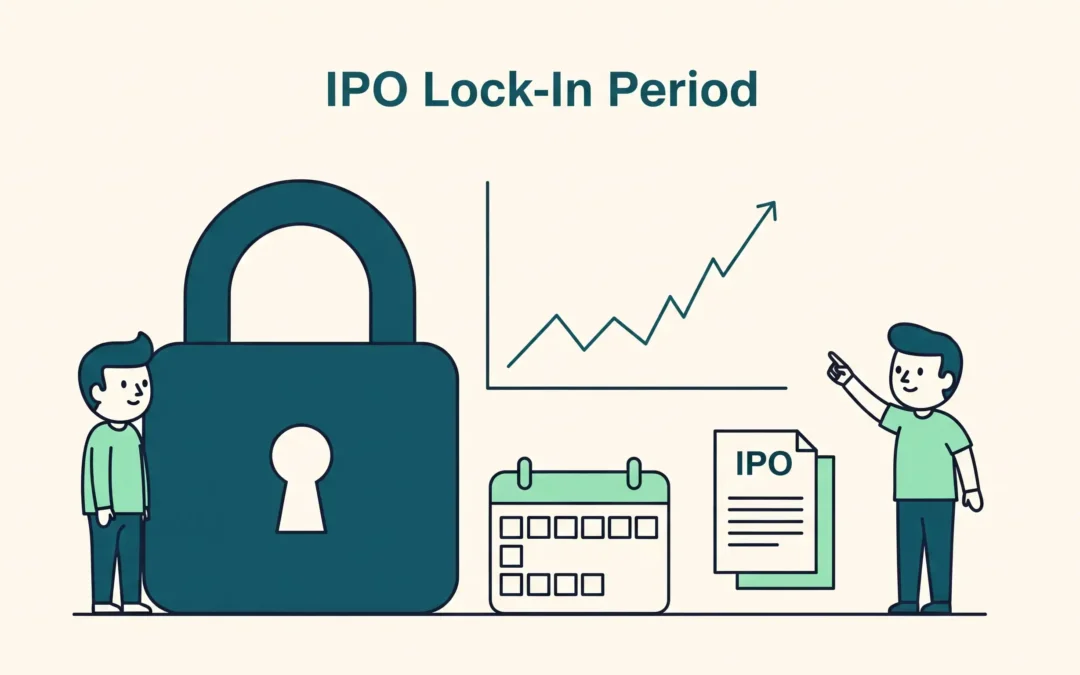IPOs are a good way to take the edge in the market. Retail investors often apply for IPO of good companies to make quick profits or even hold them for the long term. Market participants like promoters, retail investors, etc., may be interested in getting the IPO. But what is a lock-in period in IPO? Does it hold any importance for retail investors?
This article will help you understand the IPO lock-in periods and all the information that a retail investor must know to avoid loss and regret in the future.
What is an IPO Lock-in Period?
An initial public offering (IPO) lock-in period is a set amount of time following an IPO during which specific shareholders, primarily insiders or early investors, are prohibited from selling their shares on the open market. In order to preserve price stability and avoid unexpected supply shocks that might negatively impact retail sentiment shortly after listing, this is done.
Key Features:
- Trading Restriction: During the lock-in period, shareholders are not permitted to sell their shares.
- Assists in Preventing Volatility: Restricts excessive selling pressure right after listing.
- Vary by Investor Type: Promoters, anchor investors, and others have varying durations.
- RHP Disclosure: The Red Herring Prospectus makes explicit reference to lock-in timelines.
- Regulated by SEBI: The lock-in standards are enforced by the Securities and Exchange Board of India.
| Investor Type | Lock-in Period |
| Promoters / Promoter Group | The minimum promoter contribution (20% of the post-issue capital) is locked in for 18 months. Any excess promoter holding above this 20% is locked in for 6 months. |
| Anchor Investors | For IPOs below ₹10,000 crore, all anchor shares are locked in for 30 days. For IPOs of ₹10,000 crore and above, 50% are locked for 30 days, and the remaining 50% for 90 days. |
| Pre-IPO Investors | 6 months |
| Employees (via ESOPs) | Varies (generally no lock-in after listing) |
| Retail Investors | No lock-in period |
| QIBs (other than anchor) | No lock-in period |
Why Lock-in Periods Matter for Retail Investors?
The expiration of lock-in periods can have a significant impact on stock prices and market behaviour, despite the fact that retail investors are generally exempt from them. This is how it impacts you:
- Unexpected Price Drops After Lock-in Expiration
The market may be inundated with shares once the lock-in period is over. The price may drop sharply if big investors begin to sell, surprising smaller investors. - The chance to purchase the dip
It might be a good idea to get in at a lower price if a stock corrects because of lock-in expiry, but its fundamentals hold up well. - Signal of Insider Confidence
Insiders may have faith in the company’s long-term growth if they don’t sell when their lock-in period expires, which is encouraging for you as a retail investor. - Beneficial for Planning Exits
Early-entry investors can ride post-correction rallies or avoid price shocks by timing their exits before or after lock-in expiries. - Prevents Emotional Investing
Knowing how lock-ins operate helps you avoid making rash decisions, particularly when insider selling causes abrupt drops.
How to Track and Respond to Lock-in Periods?
Not only should large investors keep track of lock-in periods. You can use this information to make well-informed investment decisions with a little thought and preparation.
- Examine the Red Herring Prospectus (RHP):
Read the RHP document before submitting an IPO application; it details lock-in periods for different investor classes. - Make Use of Reliable Financial Websites:
IPO information, including impending lock-in expirations, is frequently published on platforms such as NSE India, BSE, Chittorgarh, Moneycontrol, or Screener. - Make a Lock-in Calendar:
To keep track of the lock-in expiration dates for stocks you own or keep an eye on, keep a basic Excel sheet or utilise online resources. - Track Market Activity Around Expiration Dates:
Keep an eye out for insider information or news of bulk purchases. It may provide information about future price changes. - Avoid getting influenced by emotions:
Don’t make an investment or withdraw money based solely on the lock-in expiration. To make better decisions, combine this information with sector performance, quarterly results, and company fundamentals.
Bottomline
The conclusion can be drawn that the lock-in period plays an important role in maintaining price stability and orderly trading in the market after an IPO. By restricting large shareholders and insiders from selling immediately, it helps minimize sharp price drops and protects overall market sentiment.
While lock-ins do not guarantee equal returns for all investors, they do help prevent sudden disruptions that could disadvantage retail investors. Being aware of these periods helps retail investors make more informed and emotion-free investment decisions.
It is important to track and respond to the lock-in according to the steps listed above for better profits and more informed decisions.


